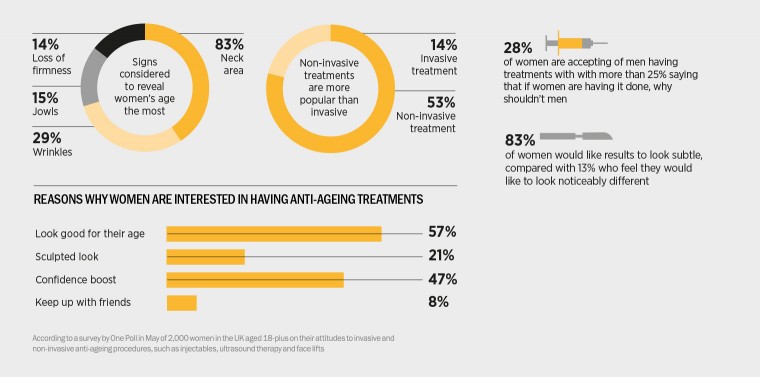The past few decades have seen huge advances in the area of non-surgical skin treatments and no more so than in the technologies available to help those who are looking to lift and tighten skin, without resorting to a surgical face lift. Although many of these innovations have made bold claims in the past, Ultherapy is the first and only energy-based device to be cleared by the FDA (Food and Drug Administration) for non-invasive aesthetic lift indication. The FDA is the US body that is responsible for assuring the safety and efficacy of all regulated medical devices, including those in the aesthetics industry. In addition, Ultherapy has been certified with the CE mark in Europe.
Ultherapy uses ultrasound, the same technology used to scan pregnant women, to deliver heat to lift and tighten skin on the face, neck and décolletage. The Ultherapy device produces ultrasound in two different ways, the first is like the one used for baby scans and sees beneath the surface to help map a patient’s unique skin layers and plan treatment. The second type is that used for treatment and has higher thermal energy intensity and is more focused. This is delivered via a handheld device, in just one session lasting no more than 90 minutes, with no downtime, no needles and no scalpels.
The initial effects can be seen within days, more sustained changes within two to three months and improvements up to one year post-treatment. In some people, these results can last for more than a year.
The initial effects of Ultherapy can be seen within days, more sustained changes within two to three months and improvements up to one year or more post-treatment
So what is it that makes Ultherapy so special? “It’s a bespoke treatment,” says Dr Tracy Mountford, (MBBS, MBCAM), founder and medical director of The Cosmetic Skin Clinic, who has been offering the procedure to her patients in her London practice and flagship clinic in Buckinghamshire, for the last year.
“Ultrasound imaging allows you to see each individual patient’s skin, which in turn allows you to set the machine so that the energy is delivered to exactly where you need it in the skin,” she says. “The treatment is precise, targeted and focused. The practitioner can visualise different levels in the skin, right down to the muscle layer in order to deliver the energy exactly where we want the sculpting and lifting to occur. This is unique to Ultherapy and means I can tailor the treatment plan for each of my patients.”
It’s long been known that heating the lower layers of the skin can stimulate production of collagen, the protein that gives skin its firmness. Until now, however, it hasn’t been possible to tailor delivery of this heat energy to each patient. Not only can Ultherapy do this, but it does it at three different levels, not just one, without heating the top layers of the skin. In this way, Ultherapy treatment avoids damaging the surface of the skin and surrounding tissue which allows patients to resume their normal daily life immediately after the procedure and without any particular post-treatment care.
“During a treatment,” says Dr Mountford, “the device is set to deliver focused energy to different levels of the skin. The first is the area of muscle that surgeons tighten during a face lift. The second targets the deep dermis where it stimulates the body to produce more collagen, and the third and final one works on the superficial layer of the skin, where the heat energy causes an immediate lifting effect, due to the proteins in these layers contracting. This sort of approach doesn’t just give an effective result, but perhaps most importantly, a natural looking one.
“As evidenced by the research carried out by Merz Aesthetics, the company behind Ultherapy in the UK, patients don’t necessarily want to look much younger, they want to look fresher,” says Dr Mountford. “It’s about looking fresher, rather than ‘done’, and Ultherapy helps me to achieve that. As part of a holistic approach, I might combine it with injectable products and the great thing is it can be used with other treatments.”
While Ultherapy could be used on anyone from their 30s to 80s, the best results tend to be on those between 40 and 60, who are starting to see laxity around the jawline, neck or décolletage. The décolletage is an area where a lot of women are having Ultherapy because it lifts and tightens very quickly and this area is a notorious giveaway of age and can often age prematurely.
“Patient selection is important,” says Dr Mountford. “The worst thing a practitioner can do is over-promise and under-deliver; however, with Ultherapy this is simply not the case. In the last year, our clinics have treated approximately 500 patients with Ultherapy, and both the results and patient satisfaction levels have been outstanding.
“Of course, a treatment is only ever as good as the practitioner, and so training and education are an important part of the support that we receive from Merz Aesthetics. We’re constantly refining and updating the protocol to ensure that every patient has the best experience, and gets the best result possible.” says Dr Mountford.
Clearly, this approach seems to be working. While Ultherapy is never going to replace cosmetic surgery, it is the perfect solution for patients who either can’t have surgery or are reluctant to have it. It’s also a flexible treatment option that can be used before or instead of a surgical face lift, but may also be used to maintain the lift effect of more conventional face-lift surgery.
It’s no wonder, with all these things considered, that Ultherapy is becoming evermore popular with practitioners and patients alike.
“Nowadays it’s all about looking the very best you can look and this technology certainly delivers,” says Dr Mountford.
The Cosmetic Skin Clinic: 01753 646660
www.cosmeticskinclinic.com/treatments/skin-tightening/ultherapy-ultrasound/
Ultherapy is manufactured by Merz Aesthetics, Elstree, WD6 3SR


